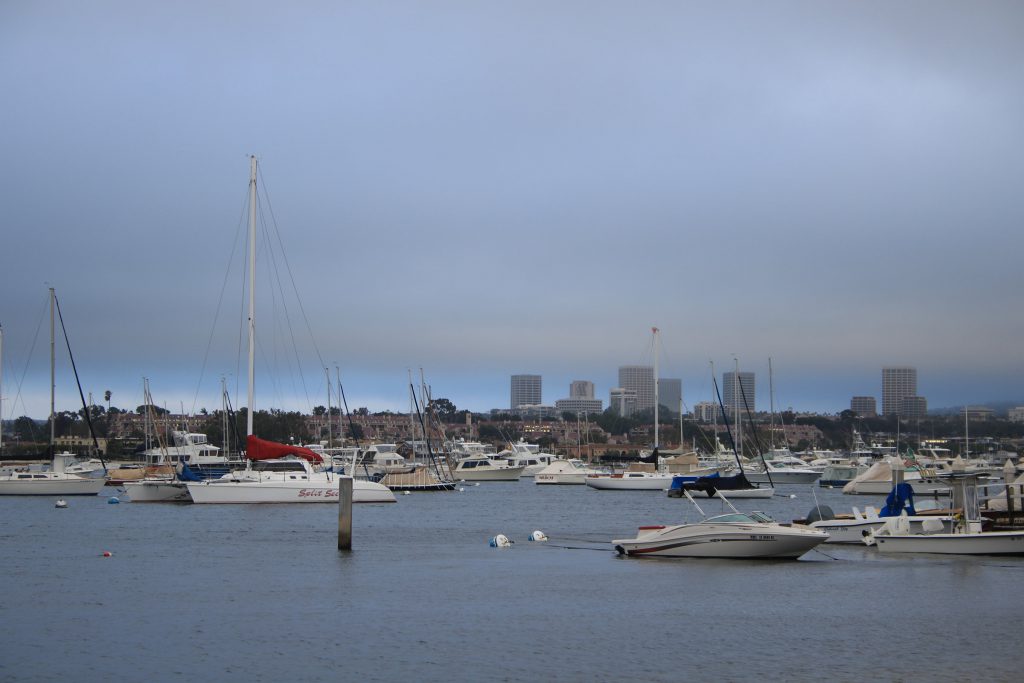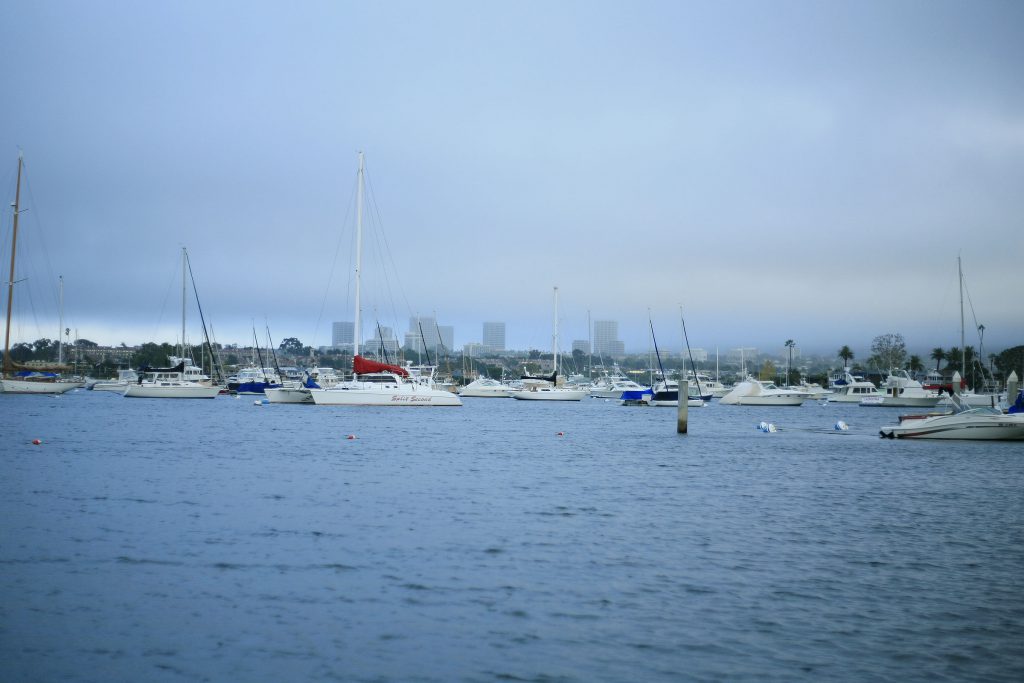
— Photo by Sara Hall ©
Plans for possibly digging a “big hole” in Newport Harbor to bury some dredged material received an icy reception from a handful of local residents at a community meeting this week.
The purpose of the proposed dredging project is to restore the harbor to “design depth” to provide necessary navigation and improve tidal flushing.
City staff’s goal is to dredge now and then “never have to think about a major dredging project again,” Public Works Manager Chris Miller explained during the public scoping meeting on the project, held Wednesday in the Friend’s Room at the Central Library. About 30 people attended the discussion.
If this is done now, there might be some cleanup projects over the years, but nothing of this magnitude in his lifetime, he added.
In partnership with the Army Corps of Engineers, the city plans to dredge approximately 1.2 million cubic yards of sediment starting in 2021 (in an ideal world, best case scenario, and dependent on funding, according to Miller). This is phase two, the first phase in 2012 dredged 600,000 cubic yards.
This project is not going to happen next month, and, the reality is, it’s not going to happen next year either, Miller said. Hopefully sometime in 2021, he added.
Council has funded all initial efforts to-date, Miller confirmed. Staff is lobbying the federal government for full funding, which is a challenge in itself, he commented.
Estimates have the price tag of about $20 million, which is dependent on a number of different factors, Miller explained.
This is a fairly significant project, Miller said.
If the removed sediment is course grained sandy material and meets quality criteria, then it is reused within the local beach zone. If the material is fine-grained and meets quality criteria, then it is disposed at an EPA approved disposal site called LA-3 about six miles from the harbor’s entrance.
About 90 percent of the sediment in the harbor is characterized as “suitable,” as evaluated by the EPA, Army Corps, California Coastal Commission, and more.
Most, about 850,000 cubic yards, of the material is suitable for open ocean disposal and will be headed to the LA-3 site.
The “beach-quality” material, about 70,000 cubic yards, will be disposed in the “near-shore” zone, just outside of where the waves break therefore letting mother nature do its job, Miller said.
The other 10 percent, nearly 100,000 cubic yards, is deemed “unsuitable material,” he explained. It’s generally the responsibility of the local agency, not the Corps.
They have to come up with a plan for all that other material, Miller commented.
Out of their very limited options, they are strongly considering a process called Confined Aquatic Disposal.
“It’s a simple and effective process,” Miller said.
The proposed CAD project includes a plan to dispose of some sediment within the harbor, essentially digging a big hole, filling it as the dredging process moves forward, using an interim cap and then a final cap can be placed once it is full. Capping is the most critical part of this concept, he noted.
It’s not a new concept and preferred by a number of agencies, Miller pointed out.
Newport Harbor CAD site is located by the anchorage, between Lido Isle and Bay Island, just off the main channel.
But there are other reasons this works. It’s spaced evenly between the areas where the material will be dredged from, so it’s practical. Also, square box is the most efficient shape when digging underwater, and this site allows for that, he explained.
To fit 150,000 cubic yards — 100,000 from the federal channel and an additional 50,00 to accommodate other material elsewhere in the harbor to assist homeowners and marinas — the hole would need to be about -47 feet deep, Miller explained. The hole would be about 450 feet by 450 feet.
“It’s a big hole,” Miller pointed out.

— Photo by Sara Hall ©
There was argument over the term “unsuitable,” which Miller clarified is the official, scientific term for this type of material. It’s determined by vigorous testing, and if the sediment characterization is higher than 1.5 parts per mercury (threshold was adjusted from the previous 1.0 limit) it’s considered “unsuitable,” according to the EPA.
“The fact that we’re dredging over a million cubic yards, that kind of caught their attention,” Miller said.
The audience overall appeared to oppose the idea of burying the dredged material within the boundaries of Newport Harbor at all.
They aren’t happy with the “unsuitable” sediment being anywhere in the harbor, said one resident, but if it’s going to be placed in the CAD, it shouldn’t be in such a major intersection in the harbor. A few people suggested two smaller holes in less busy areas, rather than one large hole.
If the “unsuitable material” is not ok to be disposed of in the ocean, residents aren’t ok with it being disposed of in the harbor, one local said.
Another called it “toxic” material and “trash.”
Resident Bob Yates said that location is already crowded and active. The plan really has to be developed to make it possible for everything that goes on in the harbor to be accommodated for, he said.
It’s a much bigger and more ambitious project than before, Yates added.
A possible alternative to the CAD hole would be to do nothing, which would essentially kick the can down the road, Miller commented.
“Let’s see if we can collaboratively deal with the sediment …and not leave it for future generations,” Miller said.
Also, he can “almost guarantee” that if they wait too long the regulations for disposal will very likely become tighter and it will be even harder to get rid of the material, Miller said.
Another alternative Miller presented on Wednesday is upland disposal. Essentially filling scows full of material, using a barge to transfer the material to a truck, mixing with some kind of chemical to help it coagulate, and then transporting it to a disposal site on land.
This process was recently used in San Diego, Miller noted, but on a much smaller scale. What the city is looking at in Newport Harbor would require quite a bit more work — and money — to pull off. It would require a “staging area,” which brings with it its own potential complications and disruption. It would take an estimated 14,000 truck trips, Miller explained, which would also strain the city’s infrastructure and traffic issues.
“I’m not sure it’s even viable,” Miller commented.
The proposal is for 10 years for the CAD to be open to assist other harbor homeowners or marinas who may want to take advantage of a placement area, Miller noted. Planning to dredge takes time. It may take less, but staff wants to plan to be able to use the CAD site for that long, if needed.
They considered other CAD locations, Miller pointed out, including on the south side of Via Lido Soud and near Marina Park. After considering others, they decided on the most central location with supportive geotechnical data that is best suited for the project.
This doesn’t mean it would be a “free for all” site, he added, people would not be allowed to just go dump in it. The city would likely announce an open period, maybe a six month long window, so people can plan and prepare, which would likely include acquiring permit.
That also doesn’t mean there would be construction equipment there the entire time, Miller confirmed.
All infrastructure needs maintenance and that is sometimes a bit inconvenient, commented Public Works Director Dave Webb.
Their aim is to cause the least amount of interruption possible, he added.
“The time to do it is now,” Webb said, they have momentum and need to improve the navigation of the harbor, which will in turn improve water quality and the flow of the bay.
The NOP is available at Newportbeachca.gov/CEQA
Comments will be accepted through Jan. 17. Submit comments to Chris Miller at cmiller@newportbeachca.gov or hand deliver them to the Public Works Department at the Newport Beach Civic Center.




